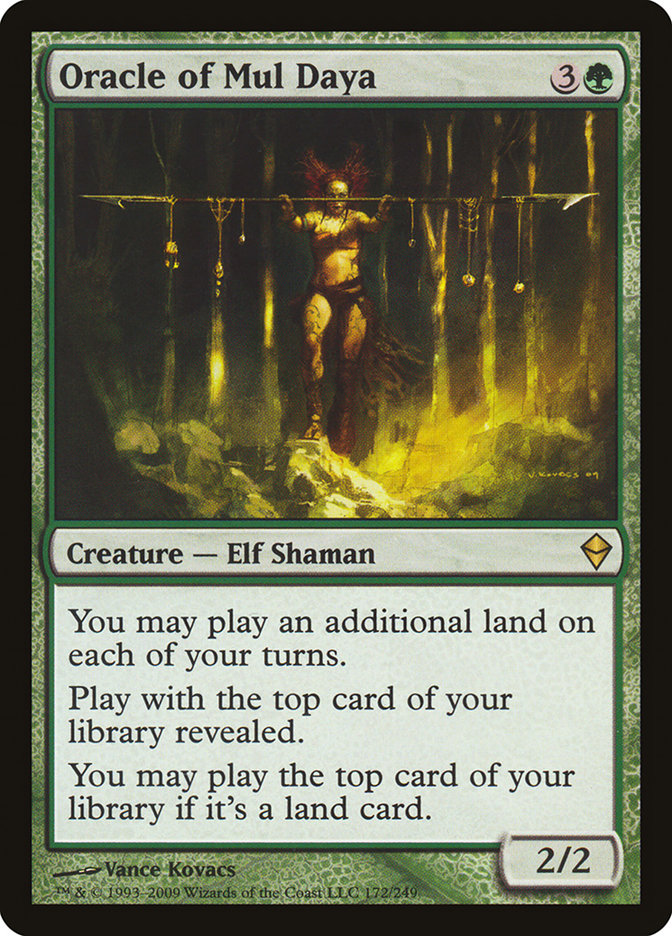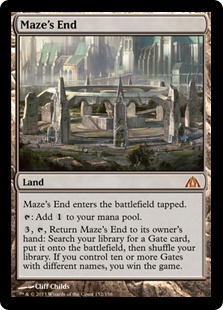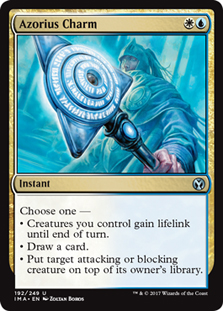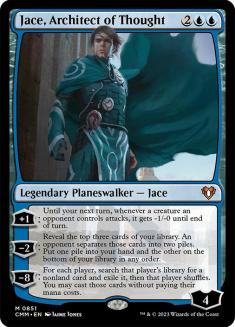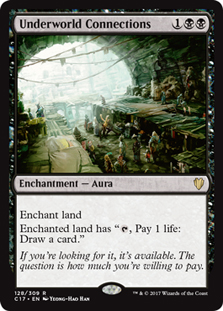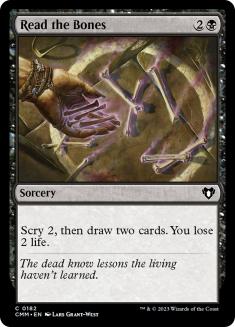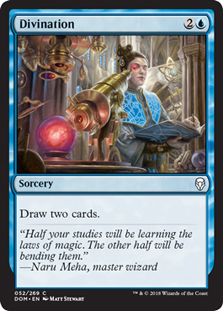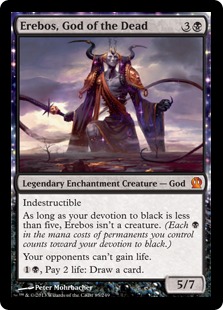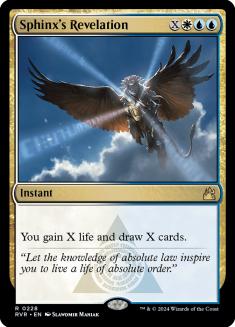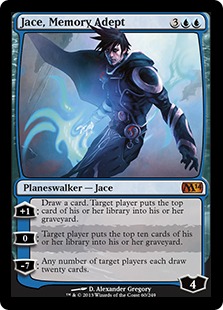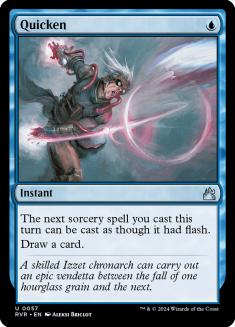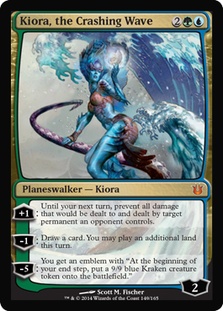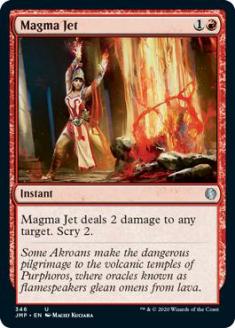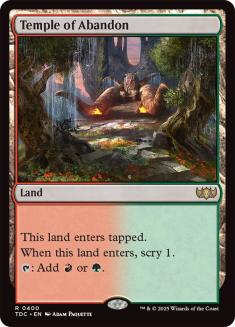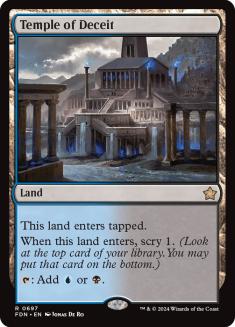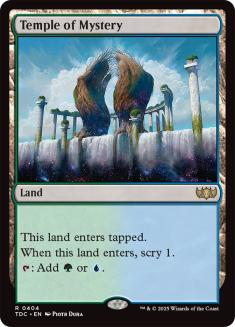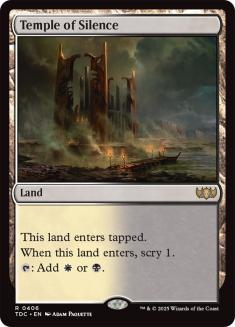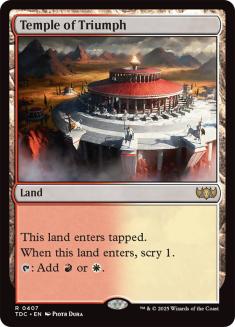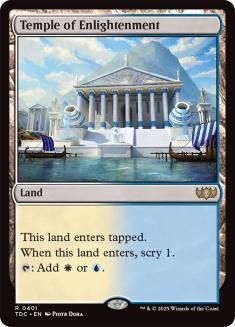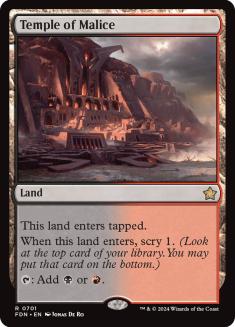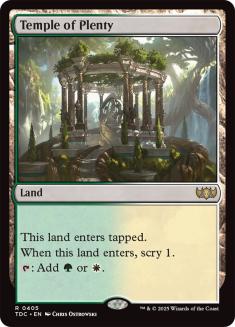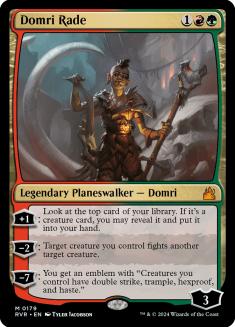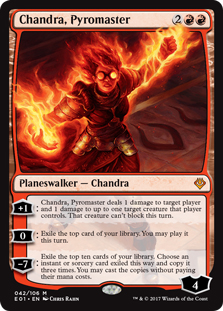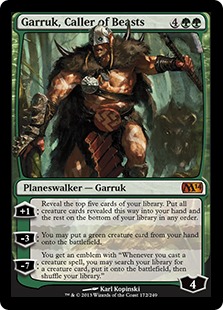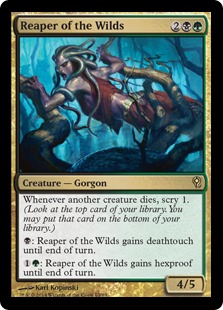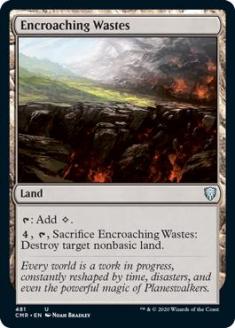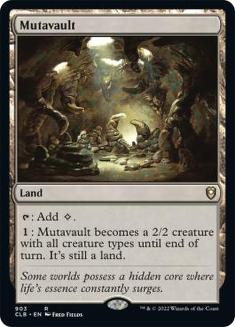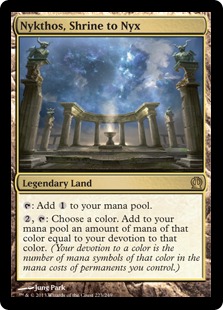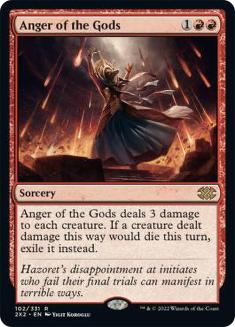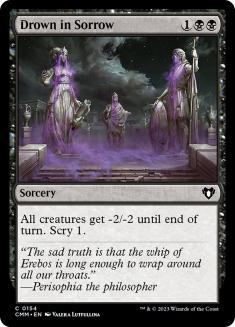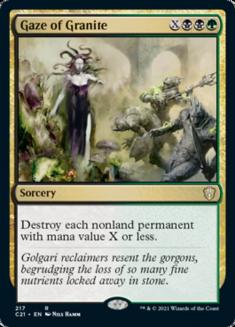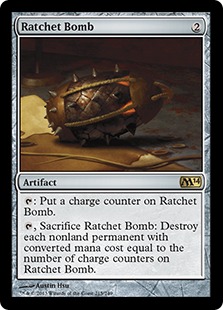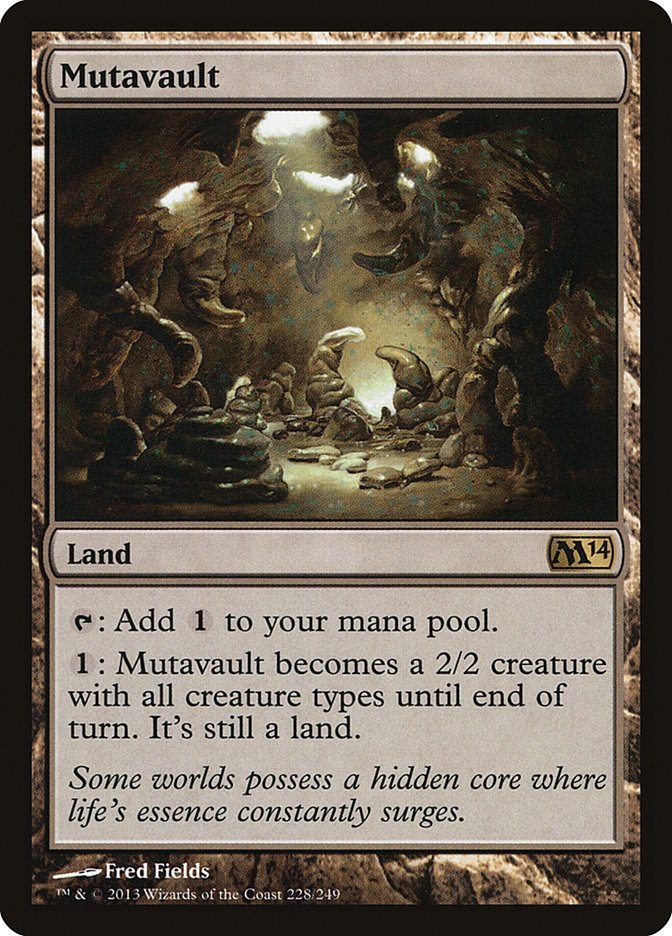Born of the Gods is about to be released, and with it will be hope for a future Standard not dominated by Mono-Black Devotion, Mono-Blue Devotion, and Sphinx’s Revelation decks. There are many reasons why these three colors are dominant, but the primary offenders are Tidebinder Mage, Master of Waves, Lifebane Zombie, and Pack Rat.
Tidebinder Mage and Lifebane Zombie are two-for-one machines, providing backbreaking disruption at low cost and zero risk. Master of Waves and Pack Rat annihilate green decks that don’t have access to the removal spells necessary to stop them from spinning the game wildly out of reach. For green decks to succeed, they need a spell that is cheap, provides card advantage, and is versatile on both offense and defense.
Gaining a life whenever you play a land is easy enough to understand, but the ability to play lands off the top of your deck is something that is extremely difficult to quantify. Fortunately, we have another card similar to it in Magic’s past to compare it to see if it will make much of an impact in the current environment.
Oracle has had an illustrious tournament-winning career spanning Block Constructed, Standard, and Extended. How about some evidence to start things off?
Block Constructed
Pro Tour San Juan in 2010 was Zendikar Block Constructed. Oracle of Mul Daya carried Paulo Vitor Damo da Rosa to the Top 8 and his first Pro Tour title.
Creatures (14)
Planeswalkers (4)
Lands (28)
Spells (14)

Standard
Grand Prix Dallas 2011 was a crazy tournament. We saw 32 Preordains and 32 Jace, the Mind Sculptors in the Top 8 (which led to the banning of Stoneforge Mystic and Jace in Standard), four RUG decks versus four Caw-Blade decks in the quarterfinals, and some guy named Michael Jacob doing battle with Oracle of Mul Daya by his side.
Creatures (12)
Planeswalkers (4)
Lands (27)
Spells (17)
Sideboard

Extended
At Grand Prix Atlanta 2011, Oracle of Mul Daya carried Ben Stark and Jason Ford to a Scapeshift mirror in the finals (this Top 8 also had both Jund and Faeries decks that might give players ideas on what to expect their Modern counterparts to look like now):
Creatures (6)
Lands (28)
Spells (26)
- 4 Lightning Bolt
- 4 Rampant Growth
- 1 Harrow
- 4 Scapeshift
- 3 Prismatic Omen
- 4 Khalni Heart Expedition
- 4 Explore
- 2 Cultivate
Sideboard

Creatures (3)
Planeswalkers (1)
Lands (27)
Spells (29)

Tournament results show that Oracle of Mul Daya dominated Block Constructed, had a solid showing in one of the most powerful Standard formats of all time (competing with Legacy powerhouses Stoneforge Mystic and Jace, the Mind Sculptor), and hoisted the trophy in an Extended format with Lightning Bolt running rampant.
Its innocuous ability is clearly more powerful than it seems, but don’t just take my word for it. Let’s examine it by going over the many things this ability is capable of:
- Shuffle effects have a chance to put a random land from your deck into play untapped by changing the top card of your library if it was not a land.
- Cantrips or draw card effects get more powerful on both sides. You will play the top card if it’s a land, so you will be more likely to hit spells. In addition, if the top card is a spell and you draw it, there’s a chance the card below that one will be a land, enhancing the effect of that draw.
- Card manipulation effects lining up lands on top instead put those lands into play. Think Halimar Depths or Brainstorm.
- Lands that are also spells are not only good because you can convert extra lands into something affecting the game, but you are also more able to do so since you will have extra lands to use them.
- Consistency. Having access to the top card if it’s a land also gives you one more chance to break out of mana or color screw, letting you mulligan less and be able to come back from mulligans with a bit of luck.
All these benefits come at a very real cost. Oracle of Mul Daya is at the end of the day a four-mana 2/2. It’s bad at both blocking and attacking and is killed by every removal spell at a great tempo loss. Playing with the top card revealed also gives your opponent information on cards in your hand and potentially perfect information if they can look at your hand with Thoughtseize (which leads to them make less mistakes and give you less room to maneuver). In addition, Oracle of Mul Daya does have an element of variance to it. Sometimes the top five cards will be nonlands or the top five will be all lands and you will be stuck wishing you were playing any other card.
The best part is that none of what I just went over is written on the card. Each aspect is learned, and each discovery is treasured as something unique to whatever it is you are trying to do. Oracle of Mul Daya has strengths, weaknesses, variance, and promotes building a deck around it to fully take advantage of its ability.
Can you tell Oracle of Mul Daya is my favorite Magic card of all time?
Now it’s time to examine whether the offspring of Oracle of Mul Daya and Grazing Gladehart (this is how centaurs are made) can make it in today’s Standard. Doing a Gatherer search of "shuffle" and "draw" leads to a ton of results, and talking about each would be silly, so I’ll go over some of the highlights here.
Shuffle Effects
Maze’s End seems like it might have potential just as a Thawing Glaciers type card, shuffling away unwanted cards and gaining two life per Courser in play (one from Maze’s End and one from the Guildgate it finds).
Cantrips
Nylea’s Presence lends itself well to a Naya strategy involving Chained to the Rocks. Underworld Connections seems like a particularly powerful combination since Courser easily balances the life loss with life gain as well as provides plenty of mana to use on the spells you draw. Both Jaces seem superior to Kiora, and there’s nothing Sphinx’s Revelation appreciates more than a couple extra lands in play.
Card Manipulation
The most intriguing part of this list is just how well removing lands from the top of your library interacts with the red and green planeswalkers. Domri and Garruk both hate seeing lands, and Chandra can always make her best decision before you decide whether to use the +0 or the +1 ability. Magma Jet looks really good on paper, but in practice there just aren’t enough two-toughness creatures worth killing. Scry lands can’t really set up your Courser because if you are using the scry you’ve already played your land for the turn, though they are good hits from the top of your deck.
Lands
Encroaching Wastes might just be worse than the other options, though it could rise in value if Maze’s End becomes popular. Mutavault is one of the most played cards in the format, so it helps that you’re encouraged to play it here.
Consistency
One- or two-color decks have been all that is possible due to mana constraints in current Standard, but Courser might change that. Splashing red in a G/B deck for Rakdos’s Return or white in a G/U deck for Detention Sphere seems very possible. For those at home willing to try to splash four cards of another color, I prefer at least ten sources (even ten Mountains for Chained to the Rocks). It’s possible to get away with eight, but I don’t recommend it.
Landfall
Gaining one life is particular powerful with Underworld Connections and Archangel of Thune. Courser helps the horrid G/W mana base to cast the five-mana Angel and even has potential of activating it multiple times and attacking the same turn if you have multiple Coursers. Definitely something to look out for.
Relevant Body
It seems strange, but the body actually lends itself to an avenue of play that Oracle of Mul Daya could not. Courser is a defensive three-drop that provides sustainable card draw with lands, meaning the opponent needs to kill it or you or eventually be defeated. This leads to people dumping their hand right into your waiting sweepers. Bile Blight may also see wide play, which is not very effective against it.
When playing Courser of Kruphix, there’s some subtle rules knowledge you should be aware of. Imagine the following:
It’s turn 4. You have three Forests in play. Your opponent has two Swamps and a Devour Flesh in their hand. You cast Courser of Kruphix. It resolves. You reveal the top card:
Without passing priority, you can play the Mutavault from the top of your deck. Playing a land can only be done on your turn when you have priority in a main phase when there is nothing on the stack. It cannot be responded to. If your opponent wishes to cast their removal spell, they may when they next have priority (likely when you pass with the gain life trigger on the stack), but the Mutavault will be in play.
Enough with the theorycrafting. On to some decklists:
Creatures (14)
Planeswalkers (1)
Lands (26)
Spells (19)

Whenever I play Mono-Black Devotion (ignoring the mirror match), I’m most pleased with Nightveil Specter when it hits lands. Courser of Kruphix provides a similar function but does not need to attack and has haste sort of because you can play the land off the top on the same turn you cast it (assuming you haven’t already made a land drop), and it blocks relatively well. This deck can go tons of different directions, with Breeding Pool and Temple of Mystery over Forests so that you can play Nightveil Specter in addition to Courser and replacing Desecration Demon with Reaper of the Wilds for a threat that’s easier to cast. You can even play Read the Bones over Underworld Connections, but eighteen black sources may be too few to fully utilize its potential.
Abrupt Decay seems very well positioned in current Standard because it’s excellent in the mirror at destroying both Pack Rat and Underworld Connections, great against control at destroying Detention Sphere, and a good removal spell against Mono-Blue Devotion. Green also gives us access to Putrefy, an easier-to-cast Hero’s Downfall that can sometimes nab Bident of Thassa or Experiment One.
Creatures (28)
- 2 Scavenging Ooze
- 4 Ghor-Clan Rampager
- 4 Elvish Mystic
- 4 Polukranos, World Eater
- 3 Sylvan Caryatid
- 4 Stormbreath Dragon
- 3 Boon Satyr
- 1 Xenagos, God of Revels
- 3 Courser of Kruphix
Planeswalkers (6)
Lands (23)
Spells (3)

The biggest drawback to playing any green deck in Standard is the terror that is Lifebane Zombie. It can take out our Polukranos, World Eater and leave either an unblockable attacker to kill our planeswalkers or an easy two-for-one blocking one of our creatures. Courser addresses this issue in multiple ways.
Courser of Kruphix is a 2/4. Unlike the alternatives like Witchstalker (aka Gnarled Mass), Scavenging Ooze, and Boon Satyr, it can attack into the 3/1 without fear. This is also incredibly convenient for Domri Rade, allowing us to -2 and fight the Lifebane Zombie with the Courser, saving our planeswalker by removing the threat without having to throw a card away. Courser also enables us to play Chandra, Pyromaster with a clear conscience, giving the Zombie a taste of his own medicine.
Using Elvish Mystic or Sylvan Caryatid to accelerate Courser out is also effective, allowing us to possibly get another land for free as soon as turn 3. Polukranos and Stormbreath Dragon happen to be great mana sinks.
Creatures (28)
- 4 Burning-Tree Emissary
- 1 Sylvan Primordial
- 4 Elvish Mystic
- 4 Polukranos, World Eater
- 1 Nylea, God of the Hunt
- 4 Sylvan Caryatid
- 3 Arbor Colossus
- 4 Voyaging Satyr
- 3 Courser of Kruphix
Planeswalkers (9)
Lands (23)

Finally, there’s G/R Devotion, a deck with many of the same strengths as G/R Monsters but that can probably use Courser even better with Garruk and more accelerators.
The sideboards for these decks are mostly thrown together, but Unravel the Aether seems interesting at defeating Thassa, Bident, and Domestication against Mono-Blue Devotion; Underworld Connections and Erebos, God of the Dead from Mono-Black Devotion; and Courser in the mirror match (randomly an enchantment creature)
I look forward to trying out all the different Courser decks that people come up with and am hoping for a vibrant Standard for the next several months!


